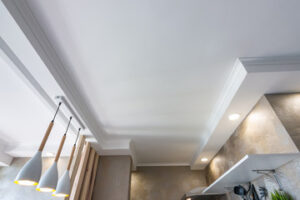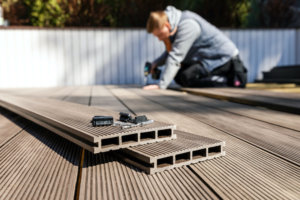Ceilings Perth may be the least-visible interior finish, but they can make as much of a difference in room design as paint and wall treatments. Decorative ceilings can add warmth and character to any space.

Conventional ceilings are the flat drywall finishes found in most homes and typically maintain an 8-foot height. These ceilings are practical and simple to maintain, and can be made more attractive with crown molding.
The ceiling has a wealth of decorating options, from painted details to carved plaster motifs. Traditional elements like coffered ceilings and crown molding add elegance, while fabric paneling brings an extra element of drama. Today, ceilings are a canvas for designers who want to create an interior with a unique look that stands out from the rest of the room.
Adding beams to the ceiling is an easy way to give rooms a rustic feel, and the beams can be stained or painted to fit any style of home.
Faux wood beams are another way to bring a rustic feel to a room, and the faux versions can be stained or painted to match any design aesthetic.
Ceiling panels can be made of a variety of materials, from wood to tin to Styrofoam. The material chosen will depend on the needs of the space, including moisture and sound dampening. Decorative ceiling panels can be a great way to add texture and visual interest to any space, and they are an excellent alternative to drywall.
Molding
The most common ceiling decoration is molding, which is often a large cornice that runs along the edge of a room, hiding the seam where the ceiling meets the wall. This ceiling element was once adorned with richly carved plaster motifs to accentuate the architectural features of a space, such as arches or bands outlining skylights.
Today, this style of ceiling is more often found in historic homes, but designers are now bringing this type of decoration to newer construction. Ceiling moldings can be carved to resemble traditional styles such as neoclassical or Georgian, or they can be more contemporary in their approach, such as incorporating geometric patterns.
Wood Ceilings
Wood ceilings add a warm, natural feel to any room. They also complement virtually any design style, from rustic and traditional to contemporary and modern. The natural grain patterns and colors of different wood species provide character that will never go out of style. Additionally, wooden ceilings are made with sustainable and renewable materials. As such, they are an eco-friendly choice for homeowners that want to make an environmentally conscious decision.
Wooden ceilings can be stained or painted to create a look that complements any room color scheme. They can even be sanded down and distressed to provide a more rustic or weathered look. They are also easy to maintain and clean, requiring only routine dusting or vacuuming to keep them looking like new.
Moreover, wood ceilings are mold- and moisture-resistant, making them an ideal solution for spaces that need to be hygienic and healthy. They are also ideal for use in kitchens, since they can easily withstand exposure to heat and steam. In addition, many wood ceilings are rated for fire safety and pass the NFPA 286 test.
The cost of a wood ceiling can vary depending on the material used, as well as regional and market-specific factors. It’s important to understand these factors when planning your budget, as they can significantly impact the overall cost of a project. Additionally, it’s important to work with a reputable supplier that can offer transparency and consistency in pricing. In doing so, you can be confident that your budget is being spent wisely and that you will receive the best product possible. Moreover, working with an experienced supplier can help minimize risks and delays that may be associated with the project.
Textured Ceilings
The type of texture used on a ceiling can dramatically impact the overall aesthetic of the room. Whether you want to create a bold and dramatic look or simply hide imperfections, there are several ways to achieve the desired result. To begin, you will need to properly prepare the space by covering all furniture and floors with protective sheeting and removing light fixtures and vents. Drywall primer should then be applied to ensure optimal adhesion of the texture mix.
Once the drywall is primed and completely dried, it’s time to start the actual texturing process. Depending on the desired style of texture, you may choose to use a paint sprayer or roller. A sprayer will offer greater precision, while a roller is ideal for applying a more uniform texture. Regardless of which method you choose, it’s essential to follow the manufacturer’s instructions for preparing the texture mix, ensuring it is at the proper consistency.
Comb ceiling textures, which involve using a comb to make lines and patterns in a layer of wet plaster or drywall compound, are one of the most basic options. This simple texture can be used in many types of rooms, and it can help to conceal minor drywall imperfections.
Skip trowel textures, which utilize techniques like stippling and swirling to create decorative finishes on ceiling surfaces, are another popular choice. These textures can be used to complement various interior design styles, and they add visual interest and depth to a room.
If you’re looking for a more subtle finish, you can also use textured paint to cover your ceilings. This product is similar to a standard paint, but it contains additives that create small shadows and depressions. If you’re going to use textured paint, be sure to select a high-quality brand that will not flake or peel.
Drop Ceilings
Drop ceilings are a common fixture in commercial spaces, basements, and homes. They consist of a grid system that supports lightweight ceiling tiles or panels, creating a secondary ceiling underneath the structural ceiling. They are commonly used to conceal piping, wiring, and ductwork, but they can also provide an opportunity for aesthetic customization.
Ceiling tiles can be purchased in a variety of colors, patterns, and textures, allowing you to add visual interest and conceal flaws in the existing ceiling. They are also easy to replace or upgrade without major renovations, giving you flexibility for future changes in your home’s design.
Depending on how they are hung, drop ceilings can offer small amounts of insulation. This can help keep your house at a more comfortable temperature, and it may also save on energy costs by reducing heating and cooling expenses. Additionally, many ceiling tiles have reflective surfaces that help brighten your room, decreasing the need for additional lighting and lowering electrical usage.
One drawback of dropped ceilings is that they typically require a framework that hangs from the existing ceiling. This can reduce head space, and it can be difficult to mount lighting fixtures or other features on a dropped ceiling.
While they’re often seen as harsh and industrial in appearance, there are now many different kinds of drop ceilings that can really add to your home’s design. They may mimic stamped tin or coffered ceilings, or they can feature decorative wood patterns like beadboard. They’re also easy to install, requiring less skill than drywall. They’re often sold as a kit that can be assembled much like flat-packed furniture. They’re also a good choice for aging houses, as they tend to shift and shrink less than traditional plaster or drywall.
Acoustic Ceilings
Acoustic ceilings, which are also known as drop ceilings or lay-in ceilings, are a popular way to dramatically change the look of a room, dampen noise, and improve lighting. They are created by placing special tiles made of mineral fiber, foam, or fiberglass into a suspended grid or directly onto the ceiling, an option known as glued ceilings. These acoustic ceiling tiles can help block outside noise from filtering in and internal sound from bouncing around the room, making them ideal for office buildings or other large spaces where the hard surface closest to where conversations take place is typically the ceiling.
Acoustic panels come in a wide range of colors and designs to complement the aesthetic of any room. They are also often fire-resistant, an important consideration for building owners with safety in mind. Additionally, acoustic ceiling panels are relatively easy to install and require minimal maintenance.
The most common type of acoustic ceiling is a drop ceiling, which utilizes a metal grid suspended from the structural ceiling in which 2×2 or 2×4 foot acoustic tiles are placed. The acoustic tiles are made of foam, mineral fiber, or fiberglass and have a general rating, known as a Noise Reduction Coefficient (NRC), that indicates the amount of ambient sounds they absorb rather than reflect. NRC ratings can vary, but higher numbers generally offer diminishing returns.
In offices, acoustic ceiling panels help block out sound from noisy areas like restrooms and hallways and allow people to communicate easier. They are also commonly used in restaurants and other dining establishments to reduce the acoustic blunder of overwhelming crowds. At home, acoustic ceiling panels are often used in home theater rooms to provide clear movie-viewing clarity and reduce distracting background noise.
